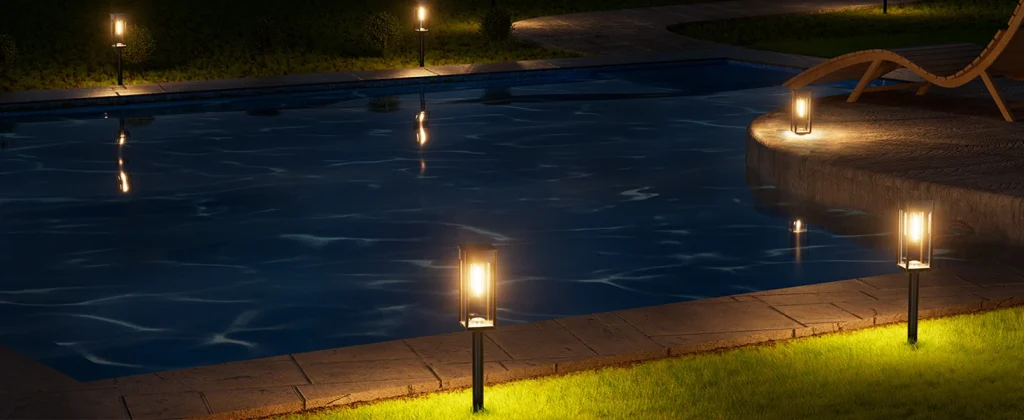North American homeowners and gardening enthusiasts often face challenges with traditional solar lights. Fixed designs struggle to adapt to evolving garden layouts, which 68% of homeowners adjust 1-2 times annually, according to a 2024 gardening survey. When a light fails, the entire unit often needs replacement, driving up costs and waste. Enter modular solar lights—a flexible, upgradeable solution that functions like building blocks. These systems allow users to adapt lighting to changing needs, reduce maintenance costs, and promote sustainability through DIY expansion. This article explores the architecture, aesthetics, and practical value of modular solar lights for North American homes.

Modular Architecture Overview
The strength of modular solar lights lies in their adaptable, user-friendly design. The system is built around three core components:
- Base Lighting Module: The foundation of the system, typically a 10W monocrystalline solar panel paired with a 500-lumen LED light. For example, a base module can illuminate a small garden path with warm 3000K light, ideal for cozy front yards. These units are compact, weatherproof (IP65), and designed for easy installation.
- Expansion Modules: These add-ons enhance functionality on demand. Options include motion-sensor modules for security, color-tuning modules for ambiance, and USB charging modules for powering devices. For instance, adding a motion-sensor module to a base light creates a battery replaceable security solution without replacing the core unit.
- Standardized Interfaces: Compatibility is ensured through standard interfaces like Type-C power connectors and snap-on mechanical mounts. Think of it like a universal phone charger—modules from different brands can work together seamlessly, addressing user concerns about incompatibility.
This modular architecture allows users to start small and scale up through DIY expansion, tailoring lighting to specific garden needs without overhauling the system.
Upgradeability and Maintenance
Upgradeable solar lighting systems are designed for longevity and ease of maintenance, offering three key advantages:
- Battery Replacement: Modules feature tool-free designs for quick battery swaps. For example, a 2-minute replacement of a standard 18650 or 21700 lithium battery extends the unit’s life. This battery replaceable approach cuts maintenance costs compared to sealed units requiring full replacement.
- Light String Expansion: A single base light string can support up to 10 additional heads, connected via standard interfaces. Using a mobile app, users can sync light effects, like dimming or color shifts, for cohesive garden aesthetics. This supports DIY expansion for larger areas without new infrastructure.
- Firmware Updates: Bluetooth or WiFi-enabled modules allow remote updates to add features like seasonal light modes or energy-saving algorithms. For example, a firmware update might introduce a “winter glow” mode, enhancing ambiance without hardware changes.
These features reduce maintenance costs to roughly $5 annually (versus $20 for traditional lights) and extend system lifespan to over 8 years, ensuring long-term value.
Design Aesthetics: The “Lighting LEGO” Approach
Modular solar lights are like LEGO bricks for outdoor spaces, combining functionality with visual appeal. Standardized module sizes (e.g., 10cm×10cm) allow creative configurations—stack vertically for pillar-like accents or align horizontally for light walls. This flexibility suits North American gardening preferences:
- Front Yard Symmetry: Uniform modules create a polished, symmetrical look, ideal for formal layouts. For example, identical base modules along a driveway deliver consistent lighting and clean aesthetics.
- Back Yard Natural Flow: Mixing modules (e.g., base lights with color-tuning add-ons) creates dynamic, organic arrangements. A main garden bed might feature a gradient light strip, blending modular solar lights with plants for layered beauty.
Imagine a backyard where base lights paired with color modules form a soft gradient along a flowerbed, enhancing both illumination and visual harmony. This DIY expansion approach ensures lighting evolves with garden redesigns, balancing practicality and style.
North American Market Applications
Modular solar lights shine in North American homes by supporting gradual upgrades from single units to complex matrices. Here are three common scenarios:
- Entryway: Start with two base lighting modules (500 lumens each) for basic path illumination. Later, add a motion-sensor module for upgradeable security, activating lights when guests approach. This ensures safety and welcomes visitors with minimal initial investment.
- Main Garden Bed: Begin with a single base module for nighttime visibility. Over time, incorporate color-tuning modules for festive modes (e.g., red-green for holidays) or ambiance strips for daily use. This creates a versatile matrix that adapts to seasonal needs via DIY expansion.
- Backyard Entertainment Zone: Install a base light string for general lighting, then expand with USB charging modules for phone power and Bluetooth speaker modules for music. This transforms a simple setup into a party-ready matrix, all using standard interfaces for easy upgrades.
Each scenario illustrates a clear path from single units to interconnected systems, meeting diverse needs while keeping costs manageable.
Cost and Lifecycle Analysis
Comparing modular solar lights to traditional single-unit lights highlights their long-term value:
- Initial Cost: A single modular unit costs $30, about 15% more than a $26 traditional light. However, a 10-unit modular system totals $300, versus $400 for equivalent traditional lights, thanks to shared infrastructure.
- Maintenance Cost: Traditional lights require full replacement upon failure, costing $20 annually. Modular systems allow targeted module swaps, reducing costs to $5 per year due to battery replaceable designs and standard interfaces.
- Lifecycle: Traditional lights last 3 years on average. Upgradeable modular systems, with replaceable batteries and firmware updates, extend lifespan to 8+ years.

10-Year Cost Comparison Table:
| System Type | Initial Cost | Annual Maintenance | 10-Year Total |
|---|---|---|---|
| Traditional Lights | $400 (10 units) | $20 | $600 |
| Modular Solar Lights | $300 (10 units) | $5 | $350 |
This 42% cost reduction over a decade makes modular solar lights a smart investment for budget-conscious homeowners.
Implementation Process and Considerations
Deploying a modular solar lighting system is straightforward with a clear process:
- Plan Scene Requirements: Identify needs per area—entryways need “lighting + motion sensing,” main beds require “color + ambiance.” Map layouts to match garden priorities.
- Select Base Modules: Choose products with standard interfaces (e.g., Type-C and snap-on mounts) to ensure multi-brand compatibility. Prioritize IP65-rated units for durability.
- Add Expansion Modules Gradually: Upgrade every 3-6 months based on feedback. For example, add color modules before holiday seasons or USB chargers for summer gatherings.
- Regular Maintenance: Check interface seals quarterly and replace batteries annually. Use battery replaceable modules to simplify upkeep.
Key Considerations:
- Waterproofing: Select IP65+ interfaces and apply waterproof sealant in rainy regions like the Pacific Northwest to protect standard interfaces.
- Load Limits: Avoid connecting more than 15 expansion modules per circuit to prevent overload, ensuring system reliability.
- Winter Storage: In cold climates like Canada, store battery modules indoors during winter to prevent damage from sub-zero temperatures.
This process empowers users to build and maintain upgradeable systems with confidence, maximizing both functionality and longevity.
Conclusion
Modular solar lights offer North American homeowners, gardeners, and outdoor decorators a versatile, cost-effective solution. Their upgradeable architecture, built on standard interfaces and battery replaceable components, supports DIY expansion from single units to dynamic matrices. With aesthetic flexibility akin to LEGO bricks, these systems adapt to evolving garden layouts while enhancing visual appeal. By reducing maintenance costs and extending lifespans, they deliver significant savings—$350 over 10 years versus $600 for traditional lights. Whether illuminating an entryway, enhancing a garden bed, or powering a backyard party, modular solar lights blend engineering, aesthetics, and practicality to meet diverse needs with ease.


Leave a Reply